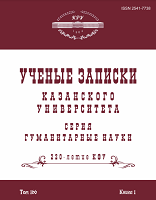Понимание незнакомого слова в тексте: различные тактики детей-монолингвов и детей-инофонов
Understanding Unfamiliar Words in a Text: Different Tactics Used by Monolingual and Foreign-Language-Speaking Children
Author(s): G.R. Dobrova, P. M. TrifonovaSubject(s): Foreign languages learning, Descriptive linguistics
Published by: Казанский (Приволжский) федеральный университет
Keywords: agnonyms; foreign-language speakers; context; word’s inner form;
Summary/Abstract: This article explores various tactics used by children to understand the meaning of unfamiliar words while reading. The study was performed on 24 children aged 8–9 years, including 12 monolinguals and 12 foreign-language speakers. In such a situation, the two primary tactics are relying on either context or the internal forms of words. The results of the experiment show that monolingual children typically focus on context, while children speaking a foreign language depend more on the inner forms of words, which often means giving priority to the second tactic and completely disregarding context, in terms of meaning and grammar. It was also revealed that the reliance on the internal forms of words persists even when all other words in a given context are clear, suggesting that children speaking a foreign language not only face challenges with comprehending certain Russian words but also have the habit of overlooking context in general. It is therefore important to address this tendency and emphasize the need for contextual understanding when working with such children.
Journal: Ученые записки Казанского университета. Серия Гуманитарные науки
- Issue Year: 166/2024
- Issue No: 1
- Page Range: 108-117
- Page Count: 10
- Language: Russian

